

"Edusites Film has completely transformed my approach to teaching, offering in-depth resources that make film analysis both accessible and engaging for my students." "The comprehensive exam materials have significantly boosted my students' confidence and performance, helping them achieve top marks in their assessments." "With Edusites Film, I save valuable time on planning, knowing I have reliable, high-quality resources that cover the entire film studies curriculum." "The variety of resources, from detailed film guides to interactive activities, keeps my students thoroughly engaged and passionate about exploring the world of film."
Objectives
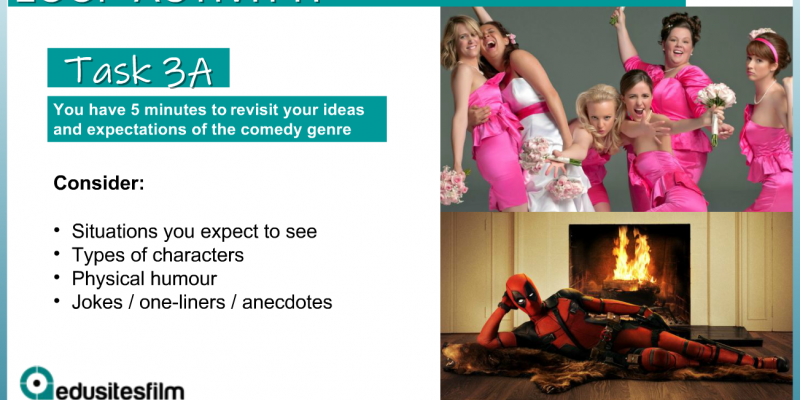
Starter/Loop Activity (5 Minutes)
Slide 2 Task 1A: Pupils asked to do the quick task and note down their response.
Prepare the Learning (15 Minutes)
Slide 3: Share the objectives. Remind students of the objectives we are working towards meeting, and that this unit is designed to help them develop knowledge and understanding of audience spectatorship theories and how these can be applied to films.
Slide 5: Students to list maximum of five favourite films (can be less if struggling) and focus on identifying their favourite scenes or moments from the films - note down and share responses with a partner. Requires teacher to lead the activity by nominating one of their favourite films and favourite scenes from this to inspire and guide student responses.
NB - one of these five films will be covered in the Loop activity.
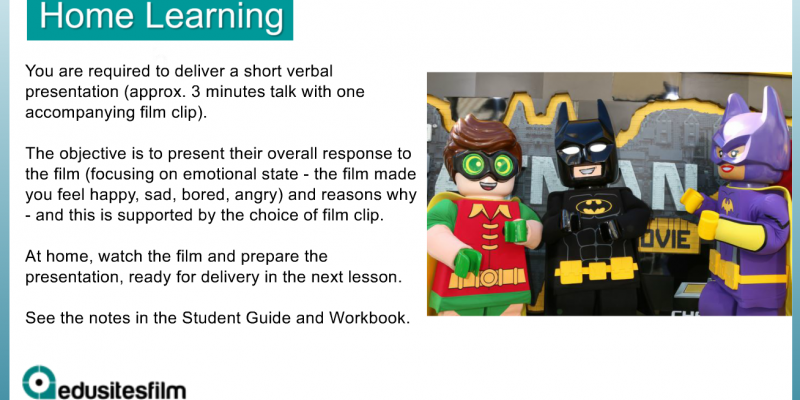
Construct the Learning (20 Minutes)
Slides 6 and 7: Show trailers from a range of films from different genres for films on current release or coming soon.
Firstly, direct students to consider their ‘attitude’ to the genre before each trailer - e.g. - teacher says, ‘science fiction’, and students respond with a word association cloud to clarify their expectations of the genre. This can be done individually, in pairs or small groups, as suits the composition of the class and teacher requirements. Teacher then directs students to consider how these genre expectations may inform their response to the film trailer.
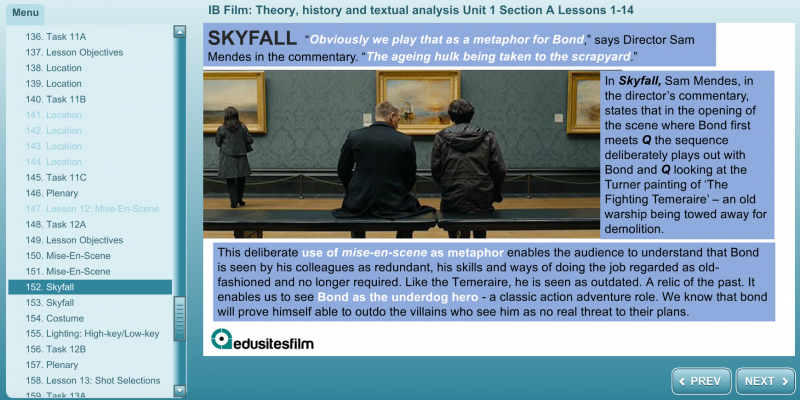
Application of Learning (15 Minutes individual work)
After the trailer for each genre is played, nominated students / groups are chosen to offer their response –
Plenary/Closing the Loop (5 Minutes individual work)
Slide 8: Students to individual summarise in writing how much they now believe generic expectations can shape or condition their responses.
Slide 10: Home Learning
Details of this are in the Student Guide on page 2 - students to do as directed, ready for presentations next lesson.
Objectives
Starter/Loop Activity (5 Minutes)
Slide 12 Task 2A: Check own presentation and final rehearsal.
Prepare the Learning (10 Minutes)
Slide 13: Share the objectives. Remind students of the objectives we are working towards meeting, and that this unit is designed to help them develop knowledge and understanding of audience spectatorship theories and how these can be applied to films.
Slide 14: Teacher to deliver short presentation of their own to set the scene and to ensure optimal presentation and learning conditions.
Construct the Learning (30 Minutes)
Students deliver their presentations, and remaining students listen and make notes in readiness or the plenary activity. (Depending on class size, presentations can be delivered to the whole class or sub-groups can be formed - important that all students deliver their presentations and that all have heard the views of others).
Application of Learning (10 Minutes individual work)
Taking the film and the presentation that the students has delivered plus the points made about two other films by two other presenters, write a prose answer to the following question:
(This is designed to enable consolidation of the learning experience plus offers an early opportunity for students to write under timed conditions and develop comparative analysis skills when writing about films).
Plenary/Closing the Loop (5 Minutes feedback to class by individuals)
Short Q&A about what has been learned from the presentations of others. Notes table on page 2 of Student Workbook.
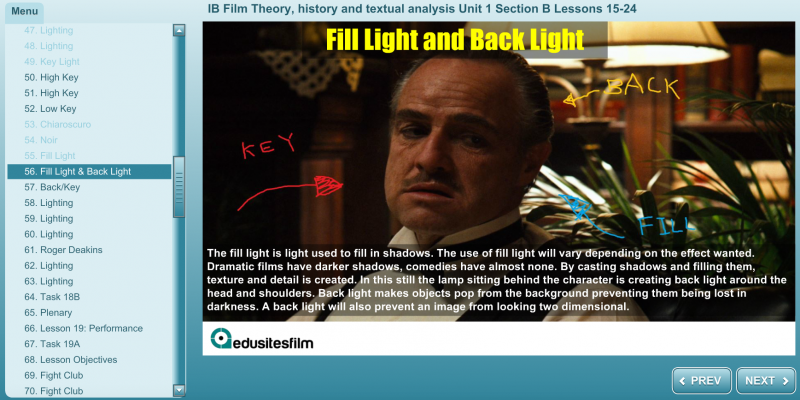
Objectives
Starter/Loop Activity (5 Minutes)
Slide 19 Task 3A: Students to discuss in pairs their ideas in response to the slide.
Prepare the Learning (5 Minutes)
Slide 20: Share the objectives. Remind students of the objectives they are working towards meeting, and that this unit is designed to help them develop knowledge and understanding of audience spectatorship theories and how these can be applied to films.
Construct the Learning (10 Minutes)
Slide 21 Task 3B Starter: Black comedy discussion.
Slide 22: Introduction to Sightseers - a ‘black comedy’ - introduce the term and define, dispel any notions that ‘black comedy’ is an ethnically / racially loaded term. Get students to reaffirm (from Lesson 1) their ideas and expectations of what a comedy film is and will contain.
Application of Learning (30 Minutes individual work)
Show some selected clips from Sightseers (with due regard to age certificate of the film and the age of the class) - key question for students: does this make you laugh? If so, why? If not, why not?
Slides 22-23: Students then to research other people's’ responses to the film by going to the user comments on imdb.com and summarise the recurring viewpoints in the first 10-20 reviews accessed (this can be differentiated by nominating students to access certain pages of reviews). Students to also research production context - budget and production companies.
Plenary/Closing the Loop (15 Minutes group discussion)
Slide 24: Discuss with others how much the size of the budget can influence the look of the films and the type of response to the film.
Slide 26: Home Learning Task set - details in their Student Guide and Workbook.
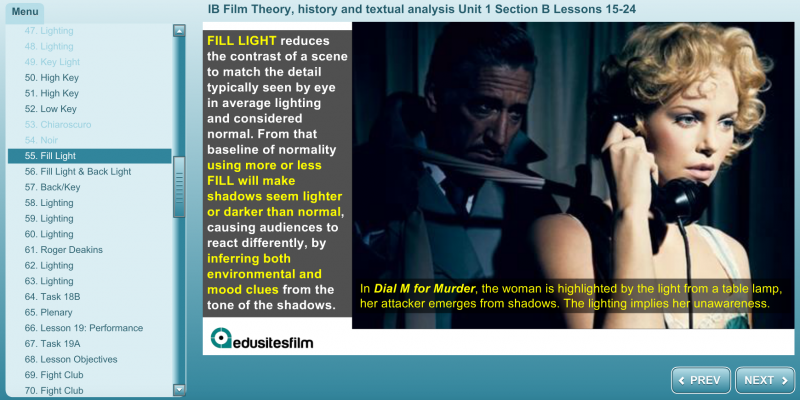
Objectives
Starter/Loop Activity (5 Minutes)
Slide 28 Task 4A: Whole class or group : verbal answers to the home learning question from previous lesson.
Prepare the Learning (10 Minutes)
Slide 29: Share the objectives. Remind students of the objectives we are working towards meeting, and that this unit is designed to help them develop knowledge and understanding of audience spectatorship theories and how these can be applied to films.
Slides 30-31: Short teacher exposition on how aspects of film language drives spectator response.
Construct the Learning (5 Minutes)
Students to be placed in small groups with separate reading / note taking tasks and then they teach each other or share notes to get the whole picture.
Application of Learning (35 Minutes work)
Slide 32: Theory reading and note taking on genre / individual narrative structure and star theory. All notes also in Student Guide and Workbook.
Slide 33: Star Theory (notes from link provided)
Slide 34: Neale’s Genre Theory (notes from link provided)
Slide 35: Narrative Theory (notes from link provided)
Plenary/Closing the Loop (5 Minutes group discussion)
Slide 37: Group discussion Task 4B - how much does the absence of stars in either Sightseers or Zootopia impact upon spectator / audience response (students may well raise points about the recognisability of some of the voice actors in Zootopia).

Objectives
Starter/Loop Activity (5 Minutes)
Slide 40 Task 5A: Intrinsic factors - listing / sorting exercise : sort the key terms in order of impact upon response to a film - the most ‘impactful’ factor goes at the top.
Prepare the Learning (5 Minutes)
Slide 41: Share the objectives. Remind students of the objectives we are working towards meeting, and that this unit is designed to help them develop knowledge and understanding of audience spectatorship theories and how these can be applied to films.
Construct the Learning (10 Minutes)
Slides 42 and 43: Exposition on the extrinsic factors - teachers can add own anecdotes on how one or more of these has made an impact on how they have responded to a film.
Application of Learning (30 Minutes individual work)
Play a film trailer on big screen in classroom in blackout conditions (if possible) then ask students to watch the same trailer on their phones - then (without warning) start playing music and / or talking very loudly next to them when trying to watch. The intention here is trying to replicate cinema conditions on one hand versus watching in a public space on a smaller device - how much do environment and viewing technology impact upon response?
Slides 44 and 45: Theory reading and note taking - Mulvey and the male gaze: first impressions: agree or disagree with central claims of the theory.
Plenary/Closing the Loop (10 Minutes group discussion / individual feedback to class)
Slide 46: Evaluating Mulvey - play The Bond Gaze clip - does the theory have a point?
Slide 48: Home Learning - go back to the film selected for presentation in Lesson 2: re-evaluate - is the male gaze at work in this film? Make one side of bullet point notes (as directed on Slide and in Student Guide).
